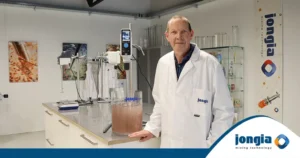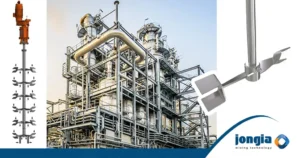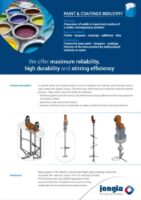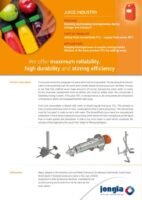The Counterflow mixing element doesn’t only move the liquid in the middle or on the outside of the tank, but both sides, in opposite directions. Jongia Mixing Technology has the Counterflow in its range, mainly for the chemical industry. The special shape of the Counterflow element and the unique way of mixing in two directions, make this agitator especially suitable for chemical applications. Hence, Jongia Mixing Technology refers to the mixing element as: ‘The Counterflow’.
Operation and placement in the tank
The Counterflow is a top entry mixing element and is often placed in the center of the tank. The Counterflow has rather large agitator blades. In width, they cover 70% to 90% of the tank. Typically, several counterflow elements, with a quantity that can run up to nine, are placed on the agitator shaft. There is plenty of room for this, as the counterflow elements are placed fairly close together. This makes the Counterflow unique compared to other mixing elements. In manufacturing the mixing element, balance is key. This makes constructing the mixing element a complex task. In the process, a lot of welding is involved and mounting the agitators on the stirrer shaft is complex and very precise. For example, the blades must be levelled out completely perfect. The blades of the Counterflow consist of a unique tuning fork at each end of the blade. The liquid is pumped down the agitator shaft in axial direction, and goes up again on the outside along the tank wall. The unique counterflow blades then cut through the liquid, creating enormous turbulence. This ensures that the liquid is properly mixed in the transition area of the liquid pumped upwards and downwards. The Counterflow is a very suitable mixing element for products such as paints, polymers (compounds that consist of a series of the same molecules) and medium-viscous liquids.
Unique mixing element for biodegradable plastics
The Counterflow is only applied where it suits best. These aren’t day-to-day processes, but chemically complex processes. For instance, Jongia Mixing Technology’s Counterflow is suitable for biodegradable plastics where starch is used as the basic component. In addition, the Counterflow can be applied in the mixing process for producing plastics such as PTA and PLA. PLA (polylactic acid) is a biodegradable plastic produced from renewable vegetable resources like lactic acid, corn starch or sugar cane. In the fields of application of the Counterflow, this agitator and its unique performance is very well known!
Want to know more?
As with all mixing processes, mixing with a specific agitator requires a targeted approach. Jongia Mixing Technology has the knowledge and experience to give you full advice in this field. Any questions? Please do not hesitate to contact us.
Contact our specialized team for all your questions

Tom Pruymboom
Sales Director
Area Worldwide

Bart Brouwer
Area Sales Manager
Area Worldwide
Technical Questions?

Jan Siert Tjeerdsma
Project Manager
Technical Specialist
In this tutorial we show you how the Counterflow moves the liquids to be mixed in two directions to create as much turbulence as possible across the entire width and length of the tank.

Tutorial: How does the Counterflow work?
The Counterflow is a very suitable mixing element for mixing processes of medium viscous liquid products such as paints, polymers and biodegradable plastics where starch is the basic component. In this tutorial we show you how the Counterflow moves the

The Counterflow: from request to solution
Mainly in the chemical industry, the Counterflow mixing element is applied in mixing processes of products such as paint, polymers, biodegradable plastics where starch is the basic component and medium viscous liquids. However, what kind of questions do the customers

The Counterflow: the top entry mixer for the chemical industry
The Counterflow mixing element doesn’t only move the liquid in the middle or on the outside of the tank, but both sides, in opposite directions. Jongia Mixing Technology has the Counterflow in its range, mainly for the chemical industry. The






